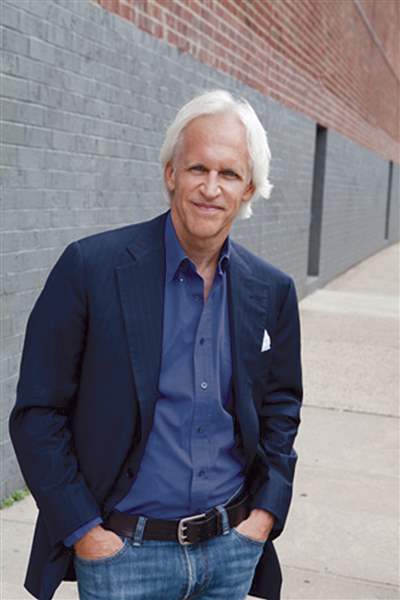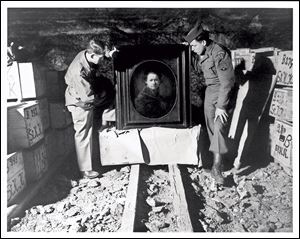
Activist works to find, preserve cultural gems
10/5/2013
Robert Edsel.

Robert Edsel.
Robert Edsel had it all in the mid-’90s, but it wasn’t enough.
His Gemini Exploration had become one of the most active horizontal oil well drillers in America and he had grown the firm from just a handful of employees to more than 100.
But he tossed it aside in 1995 and moved to Europe, selling the firm’s assets and setting off on a journey that would bring him to the forefront of a movement to protect cultural artifacts. His book The Monuments Men: Allied Heroes, Nazi Thieves and the Greatest Treasure Hunt in History has been adapted into a film of the same name starring George Clooney, Matt Damon, and Bill Murray, and he will speak Thursday at the Toledo Museum of Art about the importance of preserving cultural artifacts and treasures.
“I was 39 and my son was 2 years old and I didn’t have any time to spend with him. I was finally ahead a little bit and I had a chance to get off the merry go round,” Edsel said in a phone interview. “There were other things I was interested in doing. I didn’t have a specific thing in mind, but I knew I needed time to do it.”
While living in Florence he had what he calls the “anarchy of time” and he spent it reading voraciously and exploring the Italian city’s rich and vast art history.
“It occurred to me one day walking across the Ponte Vecchio bridge, how is it that we all know about World War II history — I mean we all know something about it and we know it’s the greatest, most destructive war in history, the loss of 65 million people’s lives, and so many of the cities in Europe were devastated — how is it that so many of the works of art survived this most destructive conflict in history and who are the people who saved them?
“I wasn’t embarrassed that I didn’t know the answer, but I was hugely embarrassed that it never occurred to me to ask the question.”
That thought kick-started a mission that led to Edsel’s three books, Rescuing Da Vinci (2006),The Monuments Men (2009), and Saving Italy: The Race to Rescue a Nation’s Treasures from the Nazis (2013).
He speaks with great conviction about the effort and the Monuments Men Foundation for the Preservation of Art, which works to ensure that cultural artifacts are returned to the countries from which they were taken.
The challenge doesn’t just revolve around World War II, he said, noting the 2001 destruction of the 6th century Buddha monuments by the Taliban in Afghanistan, the shelling of ancient Greek columns in Syria, and the U.S. failure to stop looting in Iraq when Saddam Hussein was driven out.
He said despots and radicals follow the same script of the Nazis by destroying important cultural touchstones as a way to flex their muscles and humiliate their enemies.
“This is the path of history — bad guys come along, some ‘badder’ than others — and they try to destroy what people believe in. It’s the beginning of the holocaust, lower case h, that leads then to the deaths of people,” Edsel said.
One of the goals of his foundation is to spur the Obama administration to actively speak out against the destruction of historical artifacts and devote the same level of commitment to protecting them as President Franklin D. Roosevelt did during World War II.
Edsel said lives can be saved and protected at the same time that art museums, libraries, and historical buildings are saved, with the work of the Monuments Men in World War II as a prime example of how it can be done. The Monuments Men was a group of art historians and museum curators who worked to save Europe’s great works of art from destruction during the war.

World War II soldiers discover a Rembrandt.
“They managed to deal with the humanitarian problem at the same time they were protecting cultural treasures. Why? Because President Roosevelt laid down the policy that we’re going to protect cultural treasures and General Eisenhower issued the orders and empowered these Monuments officers to execute those orders and get the job done,” he said.
The book and movie tell the story of the men and women whose jobs were to counter Nazi efforts to steal and destroy art during and after the war. They investigated the thefts and looting and attempted to return items to their rightful owners.
Edsel said that the window for finding the thousands of books, paintings, documents, and art works that still remain unaccounted for from World War II is rapidly closing.
The Monuments Men Foundation works as a clearinghouse for information regarding these items and he said no one will be prosecuted for returning artifacts as long as they are not actively trafficking in them.
“We’re not interested in how somebody got it. We’re not interested in whether it was taken, stolen, taken as a souvenir, it’s not important to me. What’s important to me is that in the twilight of some of these men’s lives that they want to do the right thing and come forward.”
Edsel said that with the exception of the Nazis, most of the people who took things in the chaotic war years and aftermath weren’t doing it for malevolent reasons.
“It was like a memento that signified they’d made it through. But in the next five to 10 years we’re going to lose all the veterans, displaced persons, and people that were affected by the war, and everything they own is going to have a new owner. This is the time to be talking about this,” he said.
The interest of Clooney and the film’s producers in the issue and the December movie will go a long way toward heightening awareness of the issue, which thrills Edsel.
“I can’t say enough good things about them and their sense of passion in telling of the story and we’re really excited about it,” he said.
One of the Monuments Men has a Toledo connection. Otto Wittman, the director of the Toledo Museum of Art from 1959 to 1976, was one of the men involved in the effort, working as a member of an intelligence agency to investigate the thefts of art work.
Edsel said Wittman interrogated former Nazi officials and was heavily involved in returning artifacts to their rightful owners.
His talk Thursday as part of the museum’s Masters Series will include a call to action to younger people to spur interest in the issue. He said they have a unique opportunity to use technology to ensure that important artistic works and documents are saved from the ravages of war.
Edsel said he currently “lives on American Airlines” as he crisscrosses the world, raising awareness of the issue and taking advantage of the buzz created by the upcoming movie.
“[The film is] going to raise worldwide awareness of this story and that’s the role of the Monuments Men Foundation — to be the catcher’s mitt for all the people that have questions, inquiries, or may have something that they have taken home whether it was a souvenir or not.”
Edsel’s lecture is supported in part by the Toledo-Lucas County Public Library and is free and open to the public. It will be followed by a book signing with the author. The talk will be at 6 p.m. Thursday in the Peristyle. Information: toledomuseum.org.
Contact Rod Lockwood at rlockwood@theblade.com or 419-724-6159.